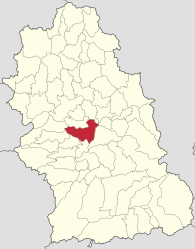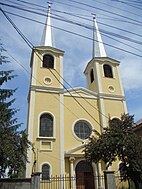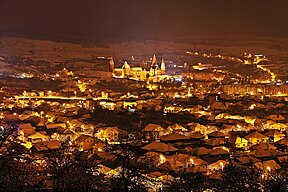
Back Hunedoara ACE هونيدوارا Arabic هوندوئارا AZB Хунедаара BE Хунедоара Bulgarian Hunedoara BJN Hunedoara BR Hunedoara Catalan Municipiul Hunedoara CEB Hunedoara Czech
Hunedoara | |
|---|---|
Bust of Avram Iancu in front of Hunedoara City Hall Roman Catholic Church Hunedoara by night, after a snowfall | |
 Location in Hunedoara County | |
| Coordinates: 45°46′11″N 22°55′13″E / 45.76972°N 22.92028°E | |
| Country | Romania |
| County | Hunedoara |
| Government | |
| • Mayor (2020–2024) | Dan Bobouțanu[1] (PSD) |
Area | 97.30 km2 (37.57 sq mi) |
| Elevation | 278 m (912 ft) |
| Population (2021-12-01)[2] | 50,457 |
| • Density | 520/km2 (1,300/sq mi) |
| Time zone | EET/EEST (UTC+2/+3) |
| Postal code | 331006–331167 |
| Area code | (+40) 02 54 |
| Vehicle reg. | HD |
| Website | www |
Hunedoara (Romanian: [huneˈdo̯ara] ⓘ; German: Eisenmarkt; Hungarian: Vajdahunyad [ˈvɒjdɒhuɲɒd] ⓘ) is a city in Hunedoara County, Transylvania, Romania. It is located in southwestern Transylvania near the Poiana Ruscă Mountains, and administers five villages: Boș (Bós), Groș (Grós), Hășdat (Hosdát; Hochstätten), Peștișu Mare (Alpestes), and Răcăștia (Rákosd).
The city includes the most important Gothic-style secular building in Transylvania: the Hunyad Castle, which is closely connected with the Hunyadi family. The castle was destroyed by fire five times, but underwent many reconstructions from Austro-Hungarian and later Romanian authorities. Besides the castle, the town developed as a production center for iron and a market for the mountain regions nearby. During the 20th century, Hunedoara's population increased to 86,000 inhabitants. The city contained the largest steel works in Romania (until Galați took the lead), but activity gradually diminished after the fall of the Iron Curtain due to the loss of the market. This was a blow to the overall prosperity of the town, which is now recovering through new investments.
The population consists of a Romanian majority, with Hungarians and Roma as the most important minorities. The city contains numerous parks, with poplars and chestnut trees flanking the streets. There are many tourist attractions, including a large dam with tourist facilities, located in the mountains a few kilometers from the city.
- ^ "Results of the 2020 local elections". Central Electoral Bureau. Retrieved 8 June 2021.
- ^ "Populaţia rezidentă după grupa de vârstă, pe județe și municipii, orașe, comune, la 1 decembrie 2021" (XLS). National Institute of Statistics.





